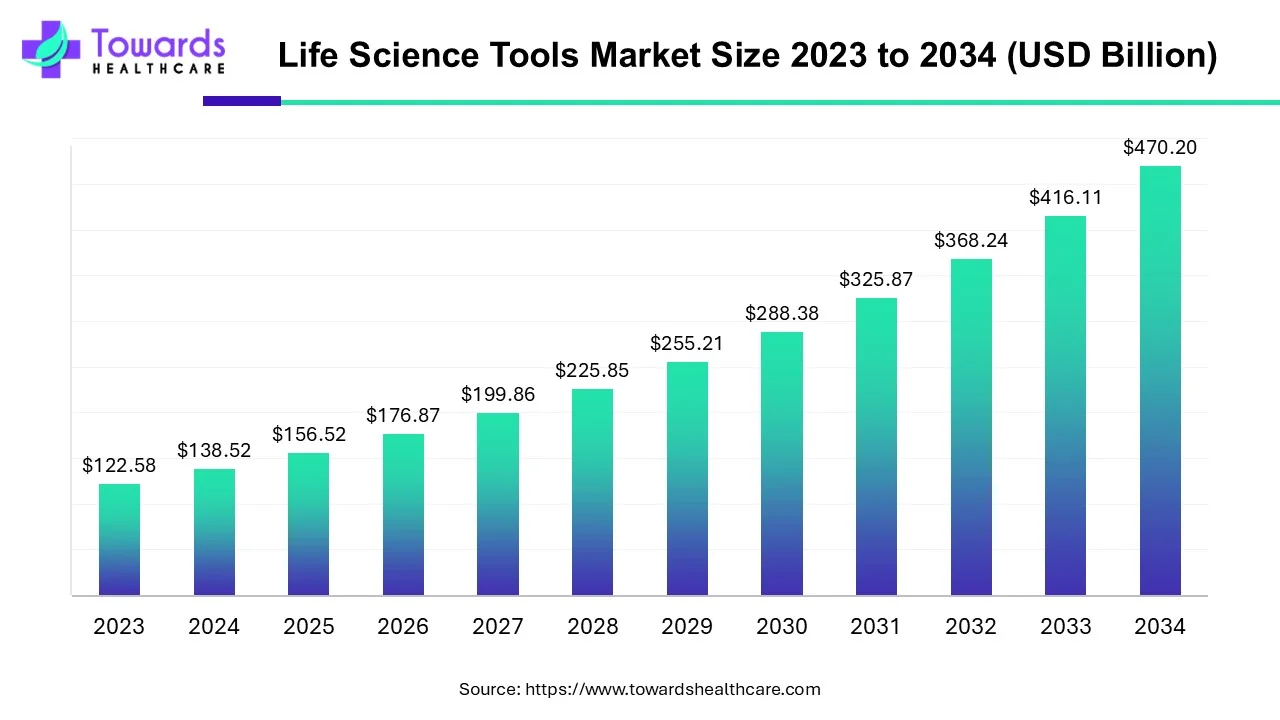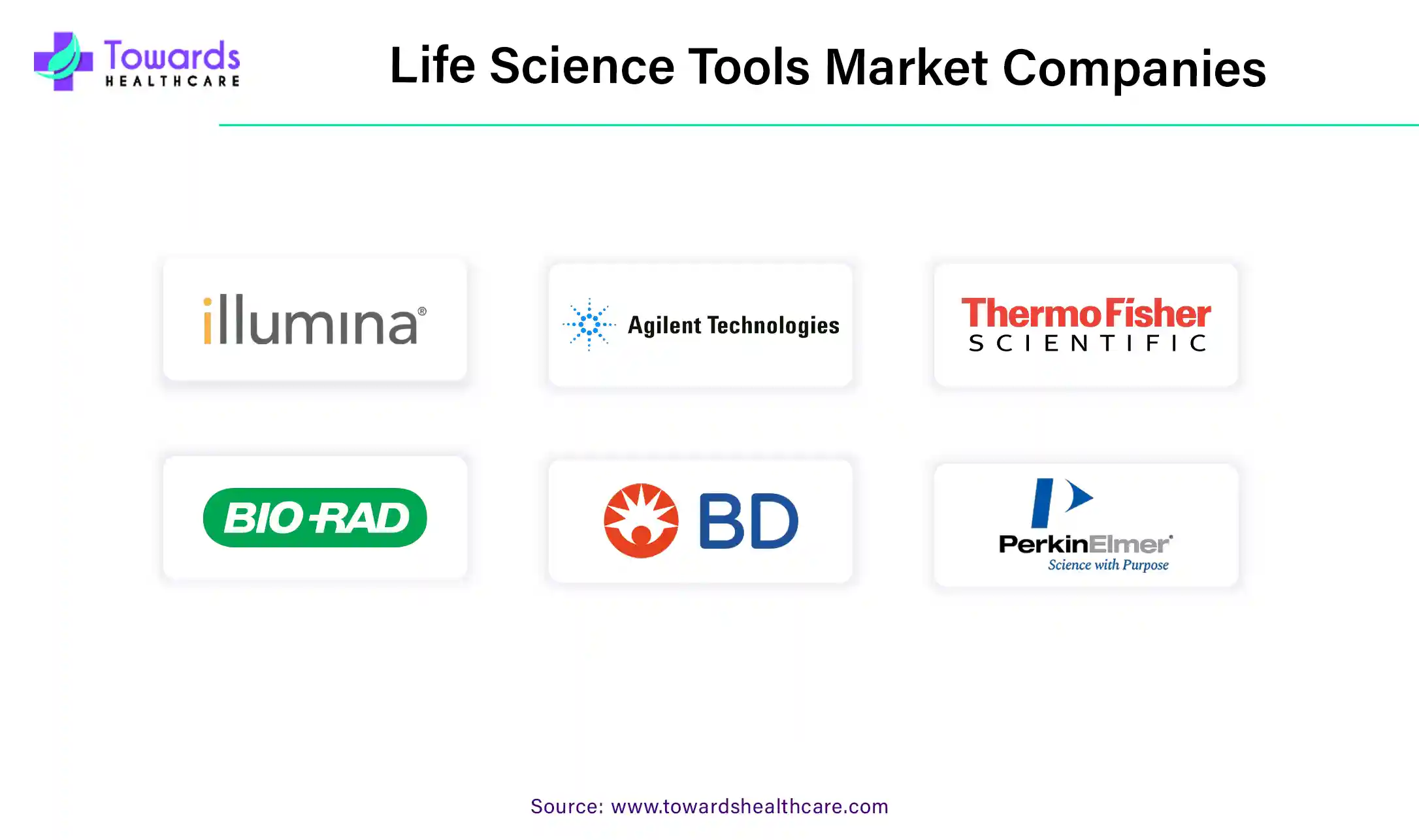March 2025

The global life science tools market size is forecast to grow at a CAGR of 13%, from USD 156.52 billion in 2025 to USD 470.20 billion by 2034, over the forecast period from 2025 to 2034, as a result of the growing R&D and technology advancements.

Unlock Infinite Advantages: Subscribe to Annual Membership
According to WHO, collaboration and digitalization have played critical roles in bringing COVID vaccines and therapies to market at an unprecedented rate, saving an estimated 750,000 lives in the United States and Europe alone, and raising demand in the global life sciences tools market.
Life sciences tools refer to various instruments, equipment, reagents, and software used in biological research, diagnostics, and drug discovery. These tools are essential for studying and manipulating biological systems at the molecular, cellular, and organism levels. Examples include DNA sequences, mass spectrometers, microscopes, gene editing tools, and various analytical instruments. Life sciences tools are crucial in advancing and understanding biology, enabling medical discoveries, and facilitating the development of new therapies and diagnostic methods.
The life sciences tools market has experienced growth due to advancements in technology, increased research activities, and rising demand for personalized medicine. Emerging fields like genomics, proteomics, and synthetic biology have driven the demand for sophisticated tools like next-generation sequencing and gene editing technologies. Additionally, the collaboration between academia and industry and government initiatives have fueled innovation, expanding the market for life sciences tools. Overall, the growing biological mechanisms and development of targeted therapies have contributed to the expansion of this market.
Life sciences tools encompass various technologies used to study living organisms. Critical applications include Genomics, Proteomics, Cell Biology, Bioinformatics, and Diagnostic Tools. The continuous advancement of life sciences tools enhances understanding of living systems and contributes to breakthroughs in medicine, agriculture, and environmental science.
Several key life science technologies contribute significantly to the market's growth. These technologies drive innovation, enhance research capabilities, and play a pivotal role in advancing our understanding of biological processes. Next-generation sequencing (NGS) technologies have revolutionized genomics research by enabling rapid and cost-effective DNA sequencing. This has led to breakthroughs in understanding genetic variations, identifying disease markers, and advancing personalized medicine. CRISPR-Cas9 has transformed molecular biology, allowing precise and targeted editing of genes. This technology has immense potential for understanding gene functions, developing therapeutic interventions, and creating genetically modified organisms for various applications.
Integrating artificial intelligence (AI) in life science tools revolutionizes the functioning of these tools, leading to enhanced accuracy and precision. It can accelerate the entire research workflow, saving a lot of time for researchers. AI-enabled life science tools help researchers analyze patient conditions, study the progression of diseases, and develop novel drugs. AI significantly reduces human intervention, decreasing manual errors. Additionally, AI can introduce automation in complex clinical trial processes. It can also aid in the large-scale manufacturing of several pharmaceutical and biological products with enhanced efficiency. Thus, AI enables medical imaging analysis, patient monitoring, predictive analytics, and regulatory compliance.
Digital Transformation in Life Sciences
Life sciences companies are increasingly integrating digital tools into their operations, yet they still trail behind other industries in digital maturity. Despite advancements, they struggle with fully leveraging digital capabilities due to misalignment of incentives and the need for agility.
Advancements in Research and Development Tools
The application of digital and analytics tools in research and development (R&D) is yielding significant benefits. These tools are helping to de-risk drug discovery, accelerate clinical trials, and enhance interactions with healthcare providers and patients. However, the full potential of these tools is still being realized.
Growth in Patents and Publications
In 2023, 3.55 million patent applications were filed globally, accounting for a 2.7% increase from 2022. Publications in digital and analytics tools for life sciences have also increased, indicating a growing focus on advancing research capabilities.
Venture Funding and Investments
Venture funding in digital health, which includes investments in life science tools, peaked during the COVID-19 pandemic and remains high. Investments have focused on tools and solutions for commercial applications, research, early development, and regulatory and safety processes. This influx of funding is driving innovation and development in life science tools.
Continuous R&D efforts lead to developing new and advanced life sciences tools with improved capabilities. Innovations in technologies such as genomics, proteomics, and molecular biology contribute to expanding the market by offering researchers more sophisticated and efficient tools for their work. R&D efforts often result in the creation of novel life sciences tools and instruments. The introduction of analytical devices and diagnostic tools attracts interest from researchers and institutions looking to enhance their capabilities, thereby driving market growth.
The accessibility of these sophisticated life sciences tools becomes restricted due to their elevated costs. Smaller organizations, educational institutions, or research labs with constrained financial resources may need help to afford the equipment. This limitation in accessibility creates an uneven playing field within the scientific community, potentially impeding the pace of discoveries and advancements.
Additionally, the high costs associated with research and development efforts in life sciences contribute significantly to the financial burden. The need for constant innovation and the incorporation of advanced technologies in tools for genomics, proteomics, and other disciplines within life sciences requires substantial investments. This financial demand can hinder the progress of research initiatives, especially for smaller research institutions or companies with limited budgets.
Furthermore, the high costs can hinder the widespread adoption of life sciences tools across diverse sectors. Healthcare, agriculture, and environmental science industries benefit from life science research advancements. However, the financial barriers may prevent these sectors from fully embracing the latest tools, slowing down the application of life sciences innovations in practical settings.
The impact of the elevated costs is a constriction of the overall expansion of the life sciences tools market. It affects the pace of scientific breakthroughs and introduces challenges in achieving a more inclusive and widely applicable approach to utilizing advancements in life sciences across various domains. Addressing these cost-related constraints is crucial for fostering a more accessible and equitable landscape for life science advancements.
In the dynamic landscape of the life sciences tools market, continuous innovation catalyzes growth and development. Novel technologies and advancements create avenues for researchers and industry professionals to discover groundbreaking solutions and address evolving challenges in the field. This ongoing innovation propels scientific discovery and presents new business opportunities, fostering competitiveness and driving progress within the life sciences sector.
In the life science industry, advancements in understanding drug interactions with patients' genetic makeup have spurred improvements in targeted therapies. Recent developments in predictive analytics and robust genetic profiling enhance the manufacturing of biological therapeutics, meeting the growing demand. The application of recombinant DNA technology in producing biologics is rising, driving market growth and positively impacting treatment outcomes while reducing drug development costs. The ongoing advancements in life sciences tools further amplify this growth trajectory.
These technologies are widely used in Life Sciences. It include,
Collaborative research initiatives among significant market players involve converting newborn stem cells from umbilical cord tissue and blood into Induced Pluripotent Stem Cells (iPSCs), creating novel market opportunities in life sciences tools.
By technology, the cell biology technology segment held a dominant presence in the life science tools market in 2024. Cell biology research focuses on in vitro study of the structure, function, and behavior of cells. Cell biology finds immense potential in drug discovery, genetics, molecular biology, medical microbiology, immunology, and cytochemistry. The advent of advanced technologies such as microfluidics, synthetic organelles, AI, 3D printing, and imaging potentiates the segment’s growth. Microscopic tools, genome analysis tools, subcellular fractionation, and liquid chromatography are essential tools for cell biology.
By technology, the genomics technology segment is predicted to witness significant growth in the market over the forecast period. The growing genomics research due to the rising prevalence of genetic and rare disorders augments the segment’s growth. Advancements in genomic technologies such as next-generation sequencing and qPCR technologies promote the segment’s growth. Genomic tools are used to study and manipulate genomic information to understand disease prognosis and develop novel therapies.
By product, the cell culture systems & 3D cell culture segment led the global market in 2024. Cell culture is a process in which cells are grown under controlled conditions after removal from living organisms. The growing drug discovery research and technological advancements fuel the segment’s growth. Cell culture is also essential for large-scale manufacturing of biological products. The increasing launch of novel biologicals and their growing demand globally necessitates the use of 2D and 3D cell culture systems. These systems are also used to study the disease prognosis and drug screening.
By product, the next-generation sequencing segment is projected to expand rapidly in the market in the coming years. Next-generation sequencing (NGS) is an advanced genetic sequencing technology that sequences multiple DNA fragments simultaneously. It can detect rare genetic variants, screen more samples cost-effectively, and produce high-throughput. Other advantages of NGS include speed, data resolution, versatility, and accuracy, making it a preferred choice among researchers.
By end-use, the healthcare segment held the largest share of the life science tools market in 2024. The burgeoning healthcare sector and the growing need for advanced diagnostics propel the segment’s growth. Life science tools help bring life-saving medications to market faster and improve patient outcomes. They promote advanced research to develop novel drugs or medical devices, enhancing the precision and sensitivity of diagnosis and treatment.
By end-use, the biopharmaceutical companies segment is anticipated to show lucrative growth in the market in the studied years. Several biopharma companies utilize advanced life science tools to revolutionize biopharmaceutical research, leading to novel and innovative solutions. These tools help them bring products faster in the market and strengthen their market position. The increasing investments and the availability of suitable infrastructure also contribute to the segment’s growth.
The rapid adoption of genomics, proteomics, oncology, and diagnostic screening primarily drives North America's dominating market of life sciences tools. The robust growth is attributed to the increasing utilization of genomic medicine, biopharmaceuticals and novel technologies for diagnosing and treating clinical disorders in the United States and Canada. The well-regulated environment in North America facilitates the approval and utilization of genomic and tissue-related technologies, further contributing to its dominance in the life sciences tools market.
For Instance,
The UK, a prominent hub for life sciences research, emphasizes the crucial role of science funding for transformative innovations benefiting patients and the public. Collaboration between academia, industry, and individuals with lived experiences is essential to address healthcare challenges like mental health, addiction, and obesity. These complex conditions necessitate life sciences innovations. This collective ingenuity significantly contributes to driving the growth of the life sciences tools market.
The projected period anticipates the Asia Pacific region to experience the highest growth, driven by global companies' investments and endeavours to leverage untapped opportunities and expand their influence. Additionally, the region's cost-effective manufacturing and research-friendly environment are poised to significantly contribute to expanding life science tools and technologies
Lionel Matthys, Chief Product Officer, Overture Life, commented that Parallel Fluidics’ microfluidic systems such as MV-2 provide advanced care in fertility treatments by precise fluid control and manage sensitive biological samples without wastage. This enables faster, more reliable processes to enhance patient outcomes and drive innovation in reproductive medicine.

By Technology
By Product
By End User
By Geography
March 2025
May 2023
January 2025